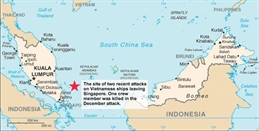
A crew member aboard a Vietnamese tanker was killed by pirates on December 7, marking a deadly escalation in Southeast Asian hijackings. The attack was the third on a Vietnamese ship in two months.
The Vietnam Maritime Search and Rescue Coordination Center said in a statement that Tran Duc Dat was shot in the forehead after the VP Asphalt 2, owned by VP Petrochemical Transport Co. in Haiphong, was attacked at 4:30 a.m. The vessel had just departed Singapore with 2,300 metric tons of liquid asphalt.
In October, a Vietnamese oil tanker was seized by pirates on the way from Singapore to Vietnam and later released. The Sunrise 689, a 5,000-tonne Vietnam-registered tanker operated by Hai Phong Sea Products, was carrying 18 crew members and about 5,000 tonnes of oil products when it disappeared from radar less than an hour after leaving Singapore in October.
Almost a week later, Sunrise 689 finally arrived at its destination. The ship had been seized by pirates, who had boarded the ship and kept the crew hostage while siphoning away almost a third of its cargo. The Associated Press reported the ship’s deputy captain as saying that the pirates put knives to the throats of the crew and threatened to kill them if they resisted.
The incidents raise questions about the safety of vessels in the region.
There have been concerns from groups such as the International Maritime Bureau that piracy is on the rise in Asia.
Dominic Johnson, a partner in the shipping practice at Holman Fenwick Willan in Singapore, says that armed robbery has historically been a problem for the South China Sea and the Malacca Straits, but that there seems to have been a shift in the nature of piracy in the region. Whereas past incidents tended to be opportunistic, unsophisticated and focused on the theft of crew’s belongings and the ship’s cash, he says, there has been a significant rise this year in the hijacking of small tankers and the theft of their cargoes.
“It appears that pirates in the region are changing their tactics to target tankers with low freeboard and slow service speeds carrying high value cargoes which can be readily sold on the black-market,” says Johnson. “This appears to be a result of piracy teams becoming larger and more organized to be able to carry out more sophisticated and lucrative attacks.”
According to a quarterly report published by the Information Sharing Centre of the Regional Cooperation Agreement on Combating Piracy and Armed Robbery against Ships in Asia, an inter-governmental organization comprising 20 countries, the number of piracy and robbery related incidents fell to 39 in the third quarter of 2014 from 58 in the second quarter.
But the total number of incidents from January to September was 129 this year, higher than that for each of the past four years. Additionally, the number of incidents falling into Category 1, or “very significant,” in the January-September period was also higher than any of the past four years. These incidents mostly consist of the siphoning of ship fuel or oil while at sea.
As for the location of incidents, there has also been an increase in the number occurring in the South China Sea and the Straits of Malacca for the January-September period – 30 and 26 respectively, according to the report. This number is significantly higher than that for previous years.
“Although there has been a continuous decline in the number of incidents over the past three months, the ReCAAP ISC is concerned about incidents involving the siphoning of fuel/oil from small tankers and therefore urges all shipowners and masters to continue to exercise enhanced vigilance while operating in the region, and adopt appropriate precautionary measures,” said the report.
Ship crews are often taken by surprise. “The skiffs used by pirates to board vessels are similar to the fishing boats that you would expect to find in the area. Attacks often take place at night, which makes detecting approaching craft all the more difficult,” says Johnson. “Seafarers are advised to exercise increased vigilance when transiting high-risk areas and be ready to deploy anti-piracy measures should any suspicious craft approach.”
As for shippers, they should make enquiries with prospective carriers to establish what measures are adopted to minimize the threat of piracy, Johnson says, and where possible, a shipper might want to avoid choosing a vessel with a slow service speed and a low freeboard, referring to the distance between the surface of the water and the level of the upper deck. These factors render a ship more susceptible to attacks.
Another factor is that sensitive data could leak into the wrong hands. “A shipper should also be vigilant and limit the disclosure of cargo and ship information for a particular voyage. The nature of recent attacks suggests that pirates have a degree of knowledge of the cargo specifications, the identity of the vessel and the route the vessel will take,” he says. “The fewer people who have access to the information, the less chance there is of a leak to pirates.”
According to a guide published by the Security Association for the Maritime Industry, which highlights the changes brought about by the industry-produced Best Management Practices for Protection Against Somalia Based Piracy, seafarers are advised to follow some ship protection measures. The premise is that if pirates are unable to board a ship they cannot hijack it.
Some measures include enhanced watchkeeping and vigilance, the control and securitization of access routes, the use of water cannons, steam or foam, the use of alarms, foghorns or whistles, and the use of closed-circuit television and upper deck lighting.
By Jeffrey Lee
Staff Writer | Hong Kong



